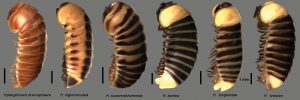Highlight Activities 2024: Six new species of the pill millipede genus Hyleoglomeris Verhoeff, 1910 (Diplopoda, Glomerida, Glomeridae) in Thailand revealed by DNA-barcoding.
Notes on the hypselostomatid snails (Gastropoda: Heterobranchia) from limestone hills in Western Cambodia with a new record and a new species
This study employs an integrative taxonomic approach to elucidate the cryptic diversity of pill millipedes belonging to the genus Hyleoglomeris Verhoeff, 1910, in Thailand. Previously, only seven species were documented within the country. Here, a combination of morphological examination and DNA barcoding, targeting the mitochondrial cytochrome c oxidase subunit I (COI) gene fragment, is utilized to describe six entirely new species: H. dracosphaera, H. nigromaculata, H. suwannakhuhensis, H. bomba, H. tongkerdae, and H. krasoon. While these newly discovered species exhibit morphological similarities, they can be differentiated based on unique color patterns, telopod structures (leg-like appendages), and specific geographic distributions within Thailand. Interspecific COI p-distances ranged from 9.01% to 16.51%, confirming their status as distinct species. Notably, the study proposes synonymy H. cavicola Likhitrakarn, Golovatch & Panha, 2015 under H. hongkhraiensis Likhitrakarn, Golovatch & Panha, 2015 due to their low genetic divergence (2.34% p-distance). This research contributes significantly to our understanding of Hyleoglomeris diversity in Thailand. Previously documented species were thought to be endemic to the region. With the inclusion of these new discoveries, the total number of Hyleoglomeris in Thailand increases to 13, nearly equivalent to the number reported in mainland China (32 species). The study emphasizes the value of DNA barcoding as a reliable tool for accurate species identification within the Glomeridae family. While morphological examination plays a role, DNA analysis offers a more precise method for distinguishing closely related species.
งานวิจัยนี้ใช้แนวทางอนุกรมวิธานแบบบูรณาการเพื่อเปิดเผยความหลากหลายที่ซ่อนเร้นของกิ้งกือกระสุนสกุล Hyleoglomeris Verhoeff, 1910 ในประเทศไทย โดยก่อนหน้านี้มีการบันทึกไว้เพียง 7 ชนิดเท่านั้น งานวิจัยนี้ใช้การผสมผสานระหว่างการตรวจสอบสัณฐานวิทยาและการวิเคราะห์รหัสพันธุกรรม (DNA barcoding) โดยมุ่งเป้าไปที่ยีน cytochrome c oxidase subunit I (COI) ในไมโตคอนเดรีย เพื่ออธิบายลักษณะของสปีชีส์ใหม่ทั้งหมด 6 ชนิด ได้แก่ H. dracosphaera, H. nigromaculata, H. suwannakhuhensis, H. bomba, H. tongkerdae และ H. krasoon แม้ว่าสปีชีส์ที่ค้นพบใหม่เหล่านี้จะมีลักษณะทางสัณฐานวิทยาที่คล้ายคลึงกัน แต่สามารถแยกแยะได้จากลวดลายสีที่เป็นเอกลักษณ์ โครงสร้างของ telopod (ส่วนยื่นที่คล้ายขา) และการกระจายพันธุ์เฉพาะถิ่นภายในประเทศไทย ความแตกต่างระหว่างสายพันธุ์จากการวิเคราะห์ยีน COI อยู่ในช่วง 9.01% ถึง 16.51% ซึ่งยืนยันสถานะของพวกมันว่าเป็นสปีชีส์ที่แตกต่างกันอย่างชัดเจน ที่น่าสนใจคือ งานวิจัยนี้นำเสนอการ กำหนดให้ H. cavicola Likhitrakarn, Golovatch & Panha, 2015 เป็นชื่อซ้ำของ H. hongkhraiensis Likhitrakarn, Golovatch & Panha, 2015 เนื่องจากทั้งคู่มีความแตกต่างทางพันธุกรรมที่ต่ำ (2.34% p-distance) งานวิจัยนี้มีส่วนสำคัญต่อความเข้าใจในความหลากหลายของสกุล Hyleoglomeris ในประเทศไทย จำนวนสปีชีส์ที่เคยบันทึกไว้ก่อนหน้านี้และคาดว่าเป็นสัตว์เฉพาะถิ่นของภูมิภาคนี้ เมื่อรวมสปีชีส์ที่ค้นพบใหม่เหล่านี้เข้าด้วยกัน ทำให้จำนวน Hyleoglomeris ทั้งหมดในประเทศไทย เพิ่มขึ้นเป็น 13 ชนิด ซึ่งใกล้เคียงกับจำนวนที่พบในจีนแผ่นดินใหญ่ (32 ชนิด) งานวิจัยนี้ยังเน้นย้ำถึงความสามารถของ DNA barcoding ในฐานะเครื่องมือที่เชื่อถือได้สำหรับการระบุชนิดพันธุ์อย่างแม่นยำภายในวงศ์ Glomeridae ในขณะที่การตรวจสอบสัณฐานวิทยามีบทบาทสำคัญ แต่การวิเคราะห์ DNA เป็นวิธีที่แม่นยำยิ่งกว่าสำหรับการแยกแยะสปีชีส์ที่ใกล้เคียงกัน
งานวิจัยครั้งนี้สอดคล้องกับเป้าหมายที่ 15. ปกป้อง ฟื้นฟู และสนับสนุนการใช้ระบบนิเวศบนบกอย่างยั่งยืน จัดการป่าไม้อย่างยั่งยืน ต่อสู้การกลายสภาพเป็นทะเลทราย หยุดการเสื่อมโทรมของที่ดินและฟื้นสภาพกลับมาใหม่ และหยุดการสูญเสียความหลากหลายทางชีวภาพ
และมุ่งในประเด็นเป้าหมายย่อย 15.4 สร้างหลักประกันว่าจะมีการอนุรักษ์ระบบนิเวศภูเขาและความหลากหลายทางชีวภาพของระบบนิเวศเหล่านั้น เพื่อจะเพิ่มพูนขีดความสามารถของระบบนิเวศเหล่านั้นที่จะให้ผลประโยชน์อันสำคัญต่อการพัฒนาที่ยั่งยืน ภายในปี 2573
Likhitrakarn, N., Jeratthitikul, E., Sapparojpattana, P., Siriwut, W., Srisonchai, R., Jirapatrasilp, P., Seesamut, T., Poolprasert, P., Panha, S., and Sutcharit, C. (2024). Six new species of the pill millipede genus Hyleoglomeris Verhoeff, 1910 (Diplopoda, Glomerida, Glomeridae) in Thailand revealed by DNA-barcoding. Contributions to Zoology. https://doi.org/10.1163/18759866-bja10062


